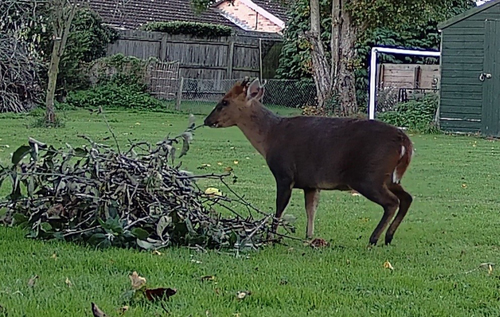By Scott Greeves
In the quiet of night, the trail camera in my garden is triggered into action by a flash of movement. Breaking the cover of the shrub line, something dashes across the camera’s infrared gaze before disappearing out of focus.

Trail camera images of the Reeves’ muntjac. Leaves from an apple tree work as camera bait. Photo: Scott Greeves
As I review the footage, the pixels fight against a copper-brown camouflage to reveal a four-legged invader. And this invader is in your garden, too.
I call it an “invader” because technically that’s what it is, an invasive species. Yet, fear not. Standing at just 50 cm tall and weighing a mere 15 kg, this undeniably charming animal is almost certainly unaware of its trespass.
Native to parts of Asia, my garden visitor is the Reeves’ muntjac (Muntiacus reevesi). This small deer is an increasingly common sighting in Reepham and the surrounding countryside.
The Reeves’ muntjac was first brought to the British Isles in 1838 by their namesake, John Reeves. Reeves, a prominent naturalist for the British East India Company, transported the deer from China to the London Zoo.
Following successful breeding, the zoo decided to sell a number of animals to Sir Herbrand Arthur Russell, 11th Duke of Bedford, in 1881. As the deer continued to thrive, the Duke released a number of them into his deer park at Woburn Abbey, Bedfordshire. Either by design or escape, the muntjac ventured beyond the reaches of the park, dispersing into the nearby woodlands.
Faced with no natural predators, the Reeves’ muntjac quickly established a wild population within England’s south-eastern forests. Since then, their population has exploded and is currently estimated to be near 150,000, with the majority of the population in the woody southeast.
The growing abundance of the Reeves’ muntjac is not without environmental concern. Some experts are worried that the animal is causing substantial impacts to woodlands and plants of conservation concern. Their herbivorous diet includes saplings and other shooting plants, which disrupts forest regrowth and other ecosystem dynamics.
My trail camera has captured their ability to trample and munch their way through an admittedly neglected vegetable and flower patch. Some local residents have taken to putting up nets to keep them out.
The species is now listed by the European Union as an “invasive alien species of Union concern”, with some UK scientists even calling for a national programme of extermination.
However, others enjoy the skittish presence of this little deer. Considering we brought them here, perhaps we must find a way to coexist and manage their negative environmental impacts.
For now, at least, it seems the Reeves’ muntjac is here to stay. Their wild population is well established and we are becoming accustomed to their loud night-time barking (yep, that’s the muntjac).
Have you seen them in your garden and are they a welcome invader?
